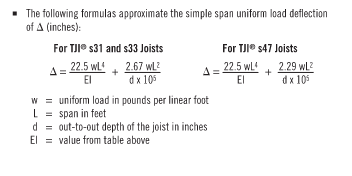TORCHMAN
Structural
- Sep 8, 2023
- 70
People in my area love using TJIs. I like spec'ing it as they have a great specifier's guide. But I realize that I am unsure about some aspects of spec'ing this product and I cannot find a good Weyerhauser contact. Does anyone here know how to get in contact with their technical team?
Below are my questions:
1) Do you guys stick to the specifier's guide or do you check deflections using their formula? I find that I can stretch the joists longer than their specifier's guide using their formula (below) while still keeping it well under the L/360 deflection. For instance, their 11-7/8" s47 TJIs @12" o.c., I can get a L/420 (19mm) with a 7.9 span (26') - 1.9kPa Live Load, 0.5kpa Dead Load, simple span. Their table only allows a 21'-10" span. That is a big difference.
I also checked for moment and shear resistances, 15.7kNm and 13.52, respectively and they are much higher than my factored moment and shear, 8.13kNm and 4.12kN, respectively
Is this issue vibration?

2) As mentioned, I use their formula for calculating deflection, but they have different allowable spans based on the different subfloors installed. This is not accounted for in their calculation. Why not? I spec 3/4" ply on longer spans that match their specifier's table, but it would be nice to derive it through an empirical formula.
Your input is appreciated!
Happy Thanksgiving!
Below are my questions:
1) Do you guys stick to the specifier's guide or do you check deflections using their formula? I find that I can stretch the joists longer than their specifier's guide using their formula (below) while still keeping it well under the L/360 deflection. For instance, their 11-7/8" s47 TJIs @12" o.c., I can get a L/420 (19mm) with a 7.9 span (26') - 1.9kPa Live Load, 0.5kpa Dead Load, simple span. Their table only allows a 21'-10" span. That is a big difference.
I also checked for moment and shear resistances, 15.7kNm and 13.52, respectively and they are much higher than my factored moment and shear, 8.13kNm and 4.12kN, respectively
Is this issue vibration?

2) As mentioned, I use their formula for calculating deflection, but they have different allowable spans based on the different subfloors installed. This is not accounted for in their calculation. Why not? I spec 3/4" ply on longer spans that match their specifier's table, but it would be nice to derive it through an empirical formula.
Your input is appreciated!
Happy Thanksgiving!
